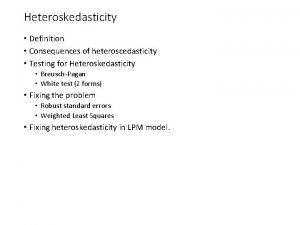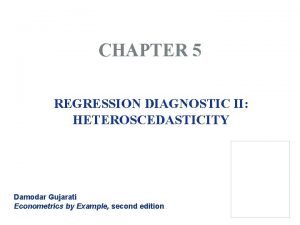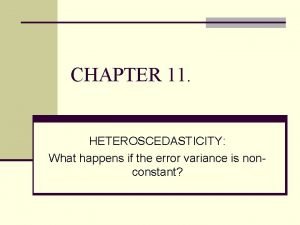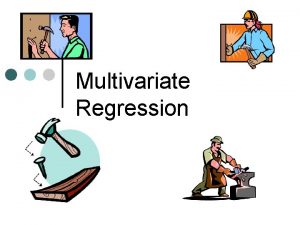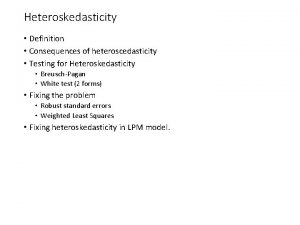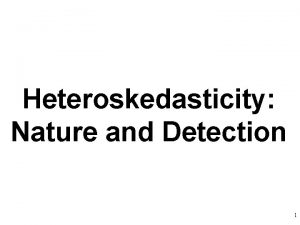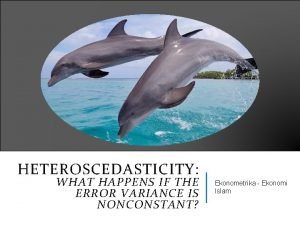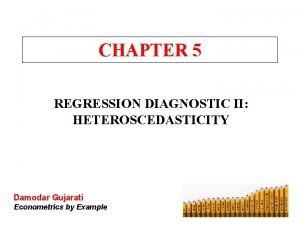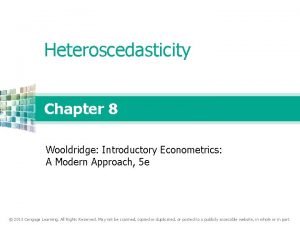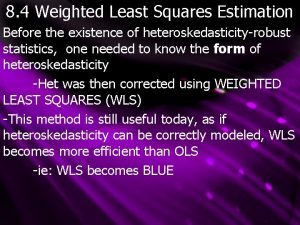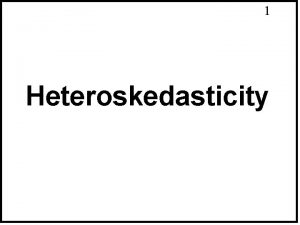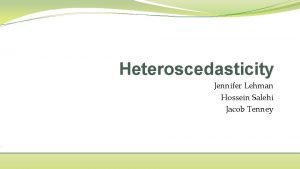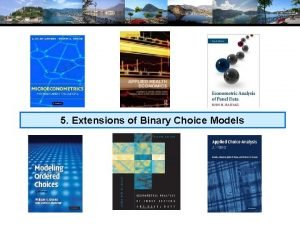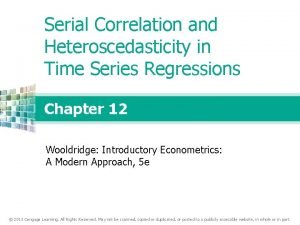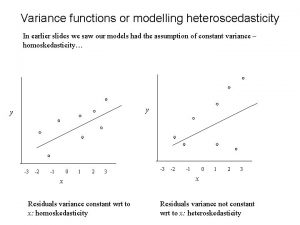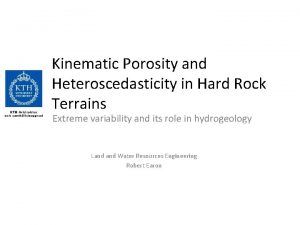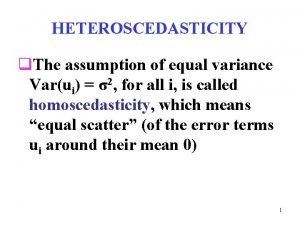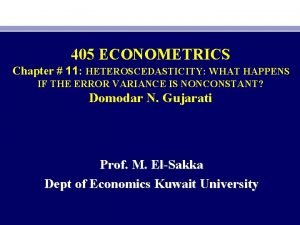Heteroskedasticity Definition Consequences of heteroscedasticity Testing for Heteroskedasticity

















- Slides: 17

Heteroskedasticity • Definition • Consequences of heteroscedasticity • Testing for Heteroskedasticity • Breusch-Pagan • White test (2 forms) • Fixing the problem • Robust standard errors • Weighted Least Squares • Fixing heteroskedasticity in LPM model.

Heteroskedasticity • Consequences of heteroskedasticity for OLS • OLS still unbiased and consistent under heteroskedastictiy • Interpretation of R-squared unchanged. Unconditional error variance is unaffected by heteroskedasticity (which refers to the conditional error variance) • Heteroskedasticity invalidates variance formulas for OLS estimators • The usual F tests and t tests are not valid with heteroskedasticity • Under heteroskedasticity, OLS is no longer the best linear unbiased estimator (BLUE); there may be more efficient linear estimators

Heteroskedasticity • Also called White/Huber/Eicker standard errors.

Heteroskedasticity • Example: Hourly wage equation Heteroskedasticity robust standard errors may be larger or smaller than their nonrobust counterparts. The differences are often small in practice. F statistics are also often similar. If there is strong heteroskedasticity, differences may be larger. To be on the safe side, it is advisable to always compute robust standard errors.

Heteroskedasticity • Testing for heteroskedasticity • Even with robust standard errors, it may still be useful to test whethere is heteroskedasticity because then OLS may not be the most efficient linear estimator anymore • Breusch-Pagan test for heteroskedasticity Under MLR. 4 The mean of u 2 must not vary with x 1, x 2, …, xk

Heteroskedasticity • Breusch-Pagan test for heteroskedasticity (cont. ) Regress squared residuals on all expla-natory variables and test whether this regression has explanatory power. A large test statistic (= a high R-squared) is evidence against the null hypothesis. Alternative test statistic (= Lagrange multiplier statistic, LM). Again, high values of the test statistic (= high R-squared) lead to rejection of the null hypothesis that the expected value of u 2 is unrelated to the explanatory variables.

Heteroskedasticity • Example: Heteroskedasticity in housing price equations Homoskedasticity rejected homoskedasticity not rejected

Heteroskedasticity • The White test for heteroskedasticity Regress squared residuals on all explanatory variables, their squares, and interactions (here: example for k=3) The White test detects more general deviations from heteroskedasticity than the Breusch-Pagan test • Disadvantage of this form of the White test • Including all squares and interactions leads to a large number of estimated parameters (e. g. k=6 leads to 27 parameters to be estimated)

Heteroskedasticity • Alternative form of the White test This regression indirectly tests the dependence of the squared residuals on the explanatory variables, their squares, and interactions, because the predicted value of y and its square implicitly contain all of these terms. • Example: Heteroskedasticity in (log) housing price equations

Heteroskedasticity • Weighted least squares estimation • Heteroskedasticity is known up to a multiplicative constant The functional form of the heteroskedasticity is known Transformed model

Heteroskedasticity • Example: Savings and income Note that this regression model has no intercept • The transformed model is homoskedastic • If the other Gauss-Markov assumptions hold as well, OLS applied to the transformed model is the best linear unbiased estimator

Heteroskedasticity • Observations with a large variance get a smaller weight in the optimization problem

Heteroskedasticity Example: Financial wealth equation Net financial wealth (in 1000 s) Stata: reg nettfa inc age_25_sq male e 401 k [aw=1/inc] Code for estimation in g: ecoevenwewls_with_401 k Participation in 401 K pension plan

Heteroskedasticity • Special cases of heteroskedasticity • If the observations are reported as averages at the city/county/state/country/firm level, they should be weighted by the size of the unit • If observations are reported as aggregates, weight by inverse of size. Average contribution to pension plan in firm i Average earnings and Percentage firm age in firm i contributes to plan Heteroskedastic error term Error variance if errors are homoskedastic at the individual-level If errors are homoskedastic at the individual-level, WLS with weights equal to firm size m i should be used. If the assumption of homoskedasticity at the individual-level is not exactly right, one can calculate robust standard errors after WLS (i. e. for the transformed model).

Heteroskedasticity • Skip sections on • feasbile GLS (8 -4 b) • prediction intervals with heteroskedasticity (8 -4 d)

Heteroskedasticity • WLS in the linear probability model In the LPM, the exact form of heteroskedasticity is known Use inverse values as weights in WLS • Infeasible if LPM predictions are below zero or greater than one • If such cases are rare, they may be adjusted to values such as. 01/. 99 • Otherwise, it is probably better to use OLS with robust standard errors

Summary of Issues with Heteroskedasticity • If heteroscedasticity exists and not corrected for • Standard errors, t-statistics, and F-statistics are wrong • Coefficient estimates are still unbiased, but inefficient • Several tests for heteroscedasticity available • Breusch-Pagan • White (2 forms) • Corrections for heteroscedasticity • Heteroskedasticity robust standard errors • No change in coefficients (still inefficient like OLS), but standard errors are correct • Weighted Least Squares • More efficient than OLS and correct standard errors • Requires knowledge of functional form for heteroscedasticity • Linear probability model requires correction for heteroscedasticity • Robust standard errors are simple fix • WLS is more efficient, but creates problems if predicted probabilities are outside unit interval.
 Consequences of heteroskedasticity
Consequences of heteroskedasticity Consequences of heteroscedasticity
Consequences of heteroscedasticity Or modelling
Or modelling Multicollinarity
Multicollinarity Heteroskedasticity definition
Heteroskedasticity definition Nature of heteroscedasticity
Nature of heteroscedasticity How to detect heteroscedasticity
How to detect heteroscedasticity Heteroscedasticity
Heteroscedasticity Lpm heteroskedasticity
Lpm heteroskedasticity Lpm heteroskedasticity
Lpm heteroskedasticity Heteroskedasticity pronounce
Heteroskedasticity pronounce Eviews training
Eviews training Domain testing
Domain testing Kv charts in software testing
Kv charts in software testing Data flow testing strategies in software testing
Data flow testing strategies in software testing Positive and negative testing
Positive and negative testing Static testing and dynamic testing
Static testing and dynamic testing Globalization testing in software testing
Globalization testing in software testing
